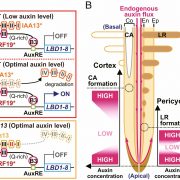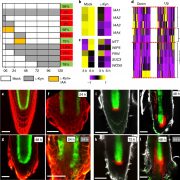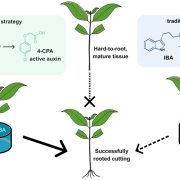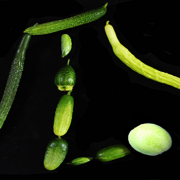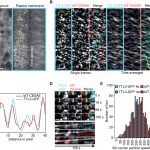Hormone distribution via hydraulic flux determines root branching
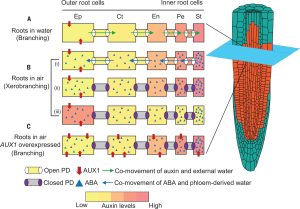 Climate change affects rain patterns and hydrological cycles all over the world, exacerbating water scarcity issues. Root branching is altered by local spatial differences in soil moisture. Indeed, when root tips temporarily lose contact with moisture, root branching stops until the appropriate moisture level is encountered again. This response is named xerobranching and in this work, Mehra et al. decipher its mechanistic basis. They prove, both genetically and with a FRET biosensor, that ABA represses lateral root development. During xerobranching response, root-tip tissues rely on an outward flux of phloem-derived water (in which ABA travels) to maintain growth. By using a fluorescent tracer, the authors demonstrated that the water flow travels through plasmodesmata, which close when they perceive ABA. The closure of plasmodesmata does not allow the required hormone auxin to travel inwards, and thus lateral roots cannot be developed. The fact that climate change is going to affect how water is distributed in the soil strengthens the need to develop resilient crops under these conditions. (Summary by Eva Maria Gomez Alvarez, @eva_ga96) Science 10.1126/science.add3771
Climate change affects rain patterns and hydrological cycles all over the world, exacerbating water scarcity issues. Root branching is altered by local spatial differences in soil moisture. Indeed, when root tips temporarily lose contact with moisture, root branching stops until the appropriate moisture level is encountered again. This response is named xerobranching and in this work, Mehra et al. decipher its mechanistic basis. They prove, both genetically and with a FRET biosensor, that ABA represses lateral root development. During xerobranching response, root-tip tissues rely on an outward flux of phloem-derived water (in which ABA travels) to maintain growth. By using a fluorescent tracer, the authors demonstrated that the water flow travels through plasmodesmata, which close when they perceive ABA. The closure of plasmodesmata does not allow the required hormone auxin to travel inwards, and thus lateral roots cannot be developed. The fact that climate change is going to affect how water is distributed in the soil strengthens the need to develop resilient crops under these conditions. (Summary by Eva Maria Gomez Alvarez, @eva_ga96) Science 10.1126/science.add3771



